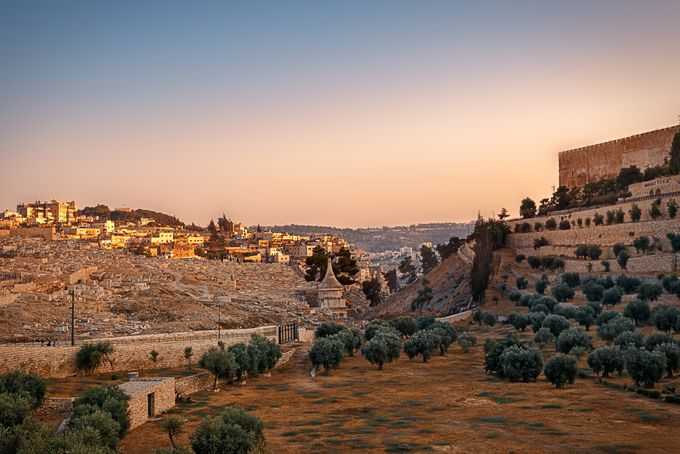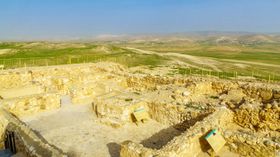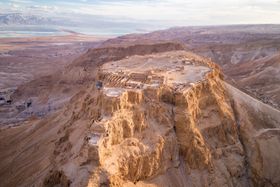18 Facts on the Holy Land - Part 1
Published April 28, 2025

The Holy Land, Israel is a region steeped in history, spirituality, and cultural richness and holds a special place in the hearts of many across the globe.
The Holy Land, Israel, is the birthplace of Judaism, Christianity, and Islam and this sacred land has been a pilgrimage destination for centuries. The Holy Land represents a symbol of faith, hope, and heritage for many.
Embarking on a pilgrimage to Israel is a profound and transformative experience for many, as it offers the unique opportunity to walk in the footsteps of the three major Abrahamic religions: Judaism, Christianity, and Islam and explore their sacred sites. This ancient land, rich in history and spiritual significance, holds a special place in the hearts of believers around the world.
Religious Significance - Religious facts on the Holy Land
The Holy Land holds deep religious significance for three religions; Judaism, Christianity and Islam. The Holy Land is the birthplace of Judaism, the location site of Jesus' crucifixion and resurrection in Christianity, and home to Al-Aqsa Mosque, the third holiest site in Islam.
Within this One, special land spanning 22,145 sq km (8,630 sq. miles) it holds such an important place in our hearts and has such historical importance.
Religious facts on the Holy Land - Judaism: The Holy Land is the Promised Land of the Hebrew Bible, with Jerusalem being at the spiritual center.
The Western Wall (Kotel) in Jerusalem - The holiest site where Jews can pray, stands as a testament to Judaism is the last remnant of the Second Temple.
The Temple Mount in Jerusalem - The site of the First and Second Temples, and the holiest place in Judaism.
The Tomb of the Patriarchs (Machpelah) in Hebron - The burial site of Abraham, Isaac, Jacob, and their wives, making it one of the most sacred places in Judaism where pilgrims come to visit and pay homage.
Religious facts on the Holy Land - Christianity: For Christians, the Holy Land is where Jesus lived, preached, died, and was resurrected. Jerusalem is regarded as one of the holiest places in the world for Christians, due to its deep-rooted connections to Jesus.
The top three most important sites in Israel for Christians are:
1. The Church of the Holy Sepulchre in Jerusalem - Is believed to be the site of Jesus' crucifixion, burial, and resurrection, making it the holiest site in Christianity.
2. The Church of the Holy Sepulchre in Jerusalem - Is believed to be the site of Jesus' crucifixion, burial, and resurrection, making it the holiest site in Christianity.
3. The Via Dolorosa in Jerusalem - The path Jesus walked on the way to his crucifixion, a significant pilgrimage route for Christians.
4. The Church of the Nativity in Bethlehem - The site traditionally recognized as the birthplace of Jesus Christ, making it a vital location for Christian pilgrims.
Religious facts on the Holy Land - Islam: The Holy Land is also sacred to Muslims, particularly Jerusalem, where the Al-Aqsa Mosque and the Dome of the Rock stand. These sites are associated with the Prophet Muhammad's Night Journey and hold profound religious significance.
The top three most important sites in Israel for Muslims are:
1. Al-Aqsa Mosque in Jerusalem - The third holiest site in Islam, believed to be the place where the Prophet Muhammad ascended to heaven during that Night Journey
2. The Dome of the Rock in Jerusalem - An iconic Islamic shrine on the Temple Mount, marking the spot where the Prophet Muhammad is said to have ascended to heaven.
3. The Ibrahimi Mosque (Tomb of the Patriarchs) in Hebron - A sacred site where Muslims honor the burial place of the Prophet Abraham.
Cultural Diversity: As stated above the Holy Land is a true melting pot of different; cultures, backgrounds, beliefs and history - this is truly what makes this small country, Israel, amazing and special. Israel’s cultural diversity is a remarkable blend of traditions, languages, and customs brought by people from all corners of the world. It is home to Jews, Christians, Muslims, Druze, and Bedouins, each contributing to the region's rich cultural tapestry.
With a diverse demographic of immigrants from five continents as well as more than 100 countries, Israel is a melting pot of cultures. As a melting pot of diverse cultures, Israel offers a vibrant array of traditions, celebrations, and experiences, making it a truly unique and captivating destination for pilgrims from all religions.
Blend of Customs and Celebrations
Israeli festivals and celebrations vividly exemplify the country's cultural diversity. Major Jewish holidays such as Succot, Hanukkah, and Yom Kippur are celebrated with enthusiasm, while Christian festivals like Christmas and Easter are marked by traditional services and processions. Muslim holidays, including Ramadan and Eid al-Fitr, are celebrated with communal prayers and feasts, while Druze and Bedouin festivals bring their own unique cultural practices to the fore. All these festivals, celebrations and mournings take place within the Holy Land and are respected by all.
The country’s cultural calendar is filled with a variety of events that highlight this rich blend of traditions.
However, one of the most diverse cultural scenes is evident in Israel’s cuisine. Israeli food is a celebration of diversity and inclusivity. From Jewish, Arab, Mediterranean, Eastern European and North African culinary traditions each with its unique flavors and techniques - the Holy Land has it all. The Holy Land truly embraces the joy of tradition together and the heartwarming background and stories woven into each ingredient sourced directly, with each one not only tasting delicious, but has a little bit of history too.
Israel boasts a rich culinary heritage with many renowned dishes, including;
hummus - Hummus, with its creamy texture and blend of chickpeas and tahini, traces its roots to ancient Middle Eastern cuisine, symbolizing the communal dining practices of the region.
shakshuka - Shakshuka, a vibrant dish of poached eggs in a spicy tomato and pepper sauce, highlights the influence of North African and Middle Eastern cooking traditions.
shawarma - Shawarma, featuring spiced, grilled meat, represents the fusion of culinary techniques brought by various cultures over centuries.
Each of these dishes is not only a testament to the region’s diverse flavors but also carries a deep historical significance that reflects the cultural preferences and traditions of the area from which it originated. These dishes, among others, weave together a narrative of cultural exchange and historical depth, making Israeli cuisine a rich tapestry of flavors and traditions. On the bustling street corners, the air is alive with a tapestry of tantalizing aromas, each scent telling a story of its origins and traditions. As you stroll, the rich, earthy fragrance of spices mingles with the smoky notes of grilling meats, inviting you to explore a world of flavors. Each vendor, with their unique accent and warm smile, is a living testament to their heritage, passionately crafting their traditional recipes into modern-day cuisine. It's a sensory symphony where the past and present collide, and every bite is a bridge to a different culture.
In part 2 of "18 Facts on the Holy Land," we will dive into Historical Highlights, Modern-Day Holy Land, and Fun and Lesser-Known Facts. Join us as we uncover the captivating stories and transformations that have shaped this remarkable region, revealing its rich past, vibrant present, and intriguing quirks that make the Holy Land truly unique.







